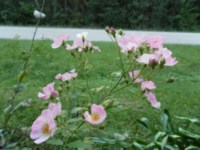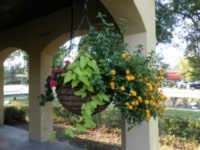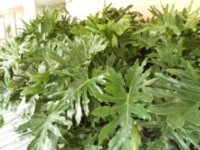
Hurricane Clean Up
With the aftermath of Hurricane Isaac, many of us are starting to clean up the tree limbs & debris in our yards and gardens. Trim any hanging limbs from trees and large shrubs. Many of these limbs can cause damage to our homes, break up our smaller plants and shrubs. You may need to add more soil & mulch to garden beds and straighten any leaning bedding plants and shrubs. Top heavy plants and shrubs can be trimmed to keep them stable. After all of the wind and rain, check soil for moisture as wind can dry out plants especially those in pots and baskets.
For more information on Hurricane preparedness and clean-up, visit the LSU AgCenter website at www.lsuagcenter.com.

Preparing Roses for Fall Blooms
Rose gardens need pruning, disease management and proper fertilization now for flowering in September and October. Late summer pruning of modern rose varieties such as hybrid tea, floribunda, grandiflora and shrub roses should be completed by early September.
Pruning should be less severe than that done in February, but it is needed to lessen disease pressure, remove old growth and improve the overall health of the plant.
Pruning accomplishes several things: height is reduced, and new growth, which results in fall flowers, is promoted. In addition, thinning out old, damaged and diseased canes will develop a desirable growth habit.
Cut back large-growing modern rose varieties to a height of 24 inches. Use sharp pruning shears, and make cuts just above outward-facing, visible, dormant buds. Cutting just above this bud will reduce the incidence of cane dieback. Clear debris from rose beds and pull any weeds that may be present. Add new mulch if you did not refresh the bed earlier in the year. Continue a preventive fungicide spray program for blackspot control. Apply a light application of a slow-release fertilizer at pruning. This improves late summer growth and fall flowering

Lantana & Plumbago for the Heat
Lantana camara or Lantana is the perfect heat tolerant and drought tolerant plant. It attracts butterflies
and hummingbirds. Lantana should be fertilized sparingly in early spring. Some popular varieties include “Ham and Eggs and New Gold.” Lantana can be used as a groundcover.
Plumbago auriculata, commonly known as Plumbago is a shrub-like perennial with tubular sky-blue flowers. ‘Alba’ has white flowers. Plumbago performs best in warm weather with a preference for morning sun & requires periodic pruning to keep it tidy. Plant in loose, fertile, moist, well-drained, slightly & acidic soil. Plumbago grows fast and prefers full sunlight. Fertilize in early spring & several times during summer with an all-purpose fertilizer.

Pest Management
Be on the lookout for pests such as lace bugs, aphids, leaf hoppers, scales, spider mites and whiteflies.
One of the worst pests of late summer is the whitefly, a small white insect slightly bigger than a gnat. Clouds of them will fly up from a heavily infested plant when it is shaken. Both the adults and the immature whiteflies feed on the plant by sucking the sap from the foliage. Infested plants will have a sickly appearance and dull leaves. A black deposit called sooty mold often appears, and leaves may turn yellow and fall off. Sooty mold may also be caused by other sucking insects such as aphids and scale.
Whiteflies often infest hibiscus, cleome, lantana, mallow, poinsettia, gardenia, Confederate rose and many bedding plants. When spraying, pay careful attention to thorough coverage on the most heavily infested plants. Repeat applications as necessary.
Plants heavily infested with whiteflies also may be cut back to reduce insect population levels. Be sure to discard the clippings.
On ornamentals you can use Talstar, Malathion, acephate or dimethoate. Although oil sprays are not recommended for use in summer when daytime highs go above 85 degrees, highly refined paraffinic insecticidal oils, such as Bonide Year Round Oil, can be used now and are effective against whiteflies. Oils kill by suffocation and are an excellent low-toxicity insecticide. Spray in the early morning when temperatures are cooler. Check the label carefully for the safe and proper use of these pesticides and the listing of plants on which they may be used.

Vegetables
Vegetables in the garden right now also are susceptible to whiteflies. Those include tomatoes, eggplants, okra, sweet potatoes, beans and others. Malathion, Bonide Year Round Oil, insecticidal soap and Thiodan should help reduce populations, but repeated applications may be necessary. Follow label directions carefully and note the waiting period between application and harvest.
A few vegetables to transplant in your garden right now are broccoli, cauliflower, cabbage, okra, collards, tomatoes, peppers, Malabar spinach and southern peas. Many vine crops will do well now, such as cucumber, squash, pumpkins and melons. Plant some yard-long beans for a late-summer snap bean substitute. Plant seeds of squash, cucumbers, bush snap beans & bush lima beans. Plant sets of shallots, bunching onions & small whole Irish potatoes.
Flowerbeds
To replant your beds, first remove the old plants and put them in your compost pile. But try to avoid putting any weeds that have set seeds in the compost. You also could spray the weeds with glyphosate herbicide (various brands) to kill them before removing them. This would be especially recommended if you are dealing with tough weeds, such as Bermuda grass, torpedograss or dollarweed.
Next, spread a 1-inch to 2-inch layer of organic matter – such as compost, bagged or aged manure, landscape soil conditioner, grass clippings or peat moss – over the bed. Sprinkle a light application of any general-purpose fertilizer (following label directions) over the organic matter and then thoroughly incorporate everything into the soil. Rake it smooth, and the bed is ready to plant.
When planting late in the growing season, choose well-established plants in 4-inch or larger pots. Make sure the plants you purchase are healthy and vigorous and
have been properly cared for. Avoid plants that look wilted or leggy, have poor color or show signs of insect or disease problems.
Gardeners often rip or pull apart the roots of root-bound bedding plants slightly when planting them into the ground. This encourages the roots to grow into the surrounding soil and helps the plant get established. But you should do this carefully or not at all when planting this time of year. Plants’ roots must absorb water rapidly to supply their needs when temperatures are hot, and transplants will not be able to tolerate much damage to their roots now.
Also be careful to plant the bedding plants at the proper depth. The top of the rootball should be level with the soil of the bed. Planting transplants too deep makes them more susceptible to root rot or crown rot. The fungal organisms that cause these diseases.
Tropical plants should be planted now so that they can become established before fall, they are not bothered by the heat and are not stressed out by it like so many other plants. Tropical hibiscus, cannas, gingers, elephant ears and other tropicals work well in the landscape now.
Now is the time to divide or transplant some plants & shrubs such as iris, Easter lilies, calla lilies & acanthus.
Order spring bulbs now to plant in the garden during October & November.
Lawns
Continue to check for chinch bugs & cut lawns high to minimize weeds and maximize health of the grass. This is especially true of St. Augustine grass. Water deeply when dry and back off when the weather is wet. You should be finished fertilizing warm season grasses for the year.
submitted by Karen Blackburn
